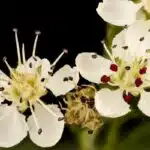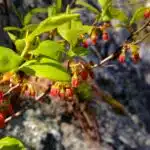Growing and caring for a black gum tree can be a rewarding experience. Black gums are known for their unique shape, vibrant fall foliage, and their ability to attract birds and wildlife. With proper growing and care techniques, these trees can provide beauty and enjoyment for many years to come.
Parallelism: Black gums require the right location, soil, sunlight, water requirements, pruning techniques, and pest control measures in order to thrive.
Engaging Style: As an experienced botanist and gardener, I am here to provide you with the advice you need to get the most out of your black gum tree. With just a little bit of knowledge on best practices in growing and caring for black gum trees, you can ensure that your tree will have the long-term health it needs to be enjoyed for generations.
Planting Black Gum Trees
The black gum, or Nyssa sylvatica, is a wonderful addition to any landscape. Often referred to as the tupelo tree, this deciduous species of tree can create a unique and beautiful display when planted in an appropriate area. As with any tree, however, there are certain steps that must be taken to ensure its health and longevity. Here we’ll explore the proper way to plant and care for your black gum trees.
When it comes to planting your black gum trees, choosing the right site is essential. The ideal spot should have plenty of sunlight and good drainage. It’s also important to ensure that the soil isn’t too acidic or alkaline, as either could lead to nutrient deficiencies in your tree. Once you find the perfect location, you’re ready to begin planting! Dig a hole twice as wide as the root ball and just as deep. Gently remove any weeds or grass from around the hole before adding soil back into it on top of the roots. Finally, pat down any extra soil around the base of your new tree and give it a generous drink of water.
Once planted properly, a few simple maintenance tasks will help ensure your black gum remains healthy for years to come. Pruning should only be done during late winter or early spring before new growth begins; over-pruning can damage mature trees so take care when cutting branches away from them. Fertilizing can also be beneficial; use an appropriate product once a year in early spring for best results. Finally, keep an eye out for pests like scale insects or borers; if found in large numbers they should be treated with an insecticidal soap spray immediately.
With these tips in mind, you’re sure to have healthy and happy black gum trees gracing your landscape in no time!
Choosing A Suitable Site
It may appear ironic that selecting the right site for a Black Gum tree can be of utmost importance, yet some gardeners would seemingly pick any spot to plant one. However, this would be a grave mistake, as the Black Gum has specific needs when it comes to its environment in order to thrive. As a specialist in botany and gardening, I urge all potential planters to consider their options carefully before making such an important decision.
The site must not only meet the needs of the tree itself but also of its desired surroundings. The soil should be acidic and well-draining, and there should be plenty of sunlight for photosynthesis. It is also necessary to ensure that the area isn’t subject to strong winds or other extreme weather conditions.
Having a subconscious desire for serving others is essential when determining the best location for your Black Gum tree – as it will need room to grow and spread its branches and roots without being crowded or exposed too much shade from other plants or buildings nearby. Therefore, consider whether or not you have enough space to accommodate this particular species’ demands before planting. With careful thought and planning, you will have found the perfect spot for your new Black Gum!
Soil Requirements
The third step in growing and caring for a Black Gum Tree is to consider the soil requirements. It’s important to keep in mind that this native tree prefers acidic soils, so it should be planted in areas with soil pH levels of 4.5 – 5.5. The ideal Black Gum Tree site should offer well-drained, moist soils, as these will provide the best growing conditions for this species. To ensure that the tree has access to enough nutrients, it’s important to also amend your soil with organic matter like compost or aged manure prior to planting.
It can also be beneficial to mulch around the base of your Black Gum Tree after planting. Mulching helps retain moisture, prevents weeds from competing with your tree for resources, and can add nutrients back into the soil over time. Be sure not to pile too much mulch on top of the root system as this can cause rot or disease issues down the road.
When caring for a Black Gum Tree once it’s established, you’ll want to monitor the soil moisture levels throughout its growing season and water when needed during periods of drought or extended dryness. With proper care and attention, your Black Gum Tree should thrive in its new home! Moving forward, we’ll discuss sunlight requirements for optimal growth and health of your Nyssa sylvatica tree.
Sunlight Requirements
Sunlight is critical for the health and growth of black gum trees. Nyssa sylvatica, commonly known as the Black Gum tree, needs full sunlight in order to reach its maximum potential. This species of tree thrives in sunny environments, so it should be planted in a location that receives at least six hours of direct sunlight per day. The best way to determine how much light a particular spot receives is to monitor it during different times of the day throughout the year.
The tree should also be protected from excessive wind exposure, as this can dry out the soil and cause damage to young branches. Additionally, make sure that any nearby structures or trees do not cast too much shade on your Black Gum tree; otherwise, it may not receive enough light for optimal growth.
In conclusion, for optimum growth and health, Nyssa sylvatica requires full sun and protection from strong winds and excessive shade. TIP: A great way to ensure your Black Gum tree gets enough sunlight is by planting it near a fence or wall that faces southward. This will provide some protection from strong winds while still allowing for plenty of sunshine!
Watering Requirements
Watering a black gum tree with the right amount of water is like giving it a healthy drink: it needs just enough to stay hydrated, but not so much that it drowns. To help you get the balance just right, here are four key tips on how to water your black gum tree:
Water frequently when the tree is young. When first planted, black gum trees should be watered at least twice a week for their first two years of growth. During this period, keep an eye out for any signs of wilting or drying out and adjust your watering schedule accordingly.
Try not to let the soil dry out completely. Black gum trees do best in moist soil, so if your garden has had a prolonged period of rainlessness, give your tree some extra love with an occasional deep watering session.
Keep mulch around the base of the tree to help retain moisture in the soil while also keeping weeds away from your precious tree’s roots.
Don’t overwater! If you notice water pooling around the trunk or leaves turning yellow or brown despite plenty of rain and sunshine, hold back on your watering schedule to prevent root rot and other diseases caused by too much moisture in the soil.
By following these guidelines for watering your black gum tree, it’ll soon be thriving in its new home! However, even with proper hydration there may come a time when pruning is necessary; let’s take a look at how best to go about doing that next…
Pruning Black Gum Trees
Like a sculptor with their chisel, the careful pruning of black gum trees can bring out their natural beauty. Pruning these trees is like giving them a haircut, ensuring they reach their full potential in terms of size and shape. For those looking to have a healthy, attractive black gum tree in their yard, pruning is essential.
One should begin pruning and training black gum trees when they are young. This will help create a strong structure that will support the tree as it matures and grows older. Branches should be evenly spaced along the trunk and no branches should cross each other. This can be done using either hand pruners or shears.
Once the desired shape has been achieved, one can look ahead to maintaining it via regular pruning sessions during the growing season. The purpose of such maintenance is to remove any dead or diseased wood, as well as any crossing branches or suckers from below the graft union (if applicable). By keeping up on this type of regular maintenance one can ensure that their black gum tree stays healthy for years to come.
Fertilizing a black gum tree is an important part of its overall health and longevity, and something that shouldn’t be overlooked in its care plan.
Fertilizing Black Gum Trees
Fertilizing black gum trees is an important part of their care, as it can help them to thrive and reach their full potential. As luck would have it, this step in their maintenance is relatively easy:
- Start by using a slow-release fertilizer that’s specifically designed for acid-loving plants.
- Spread the fertilizer around the tree, making sure to keep it away from the trunk itself.
- Water deeply afterward to make sure the nutrients are absorbed into the soil.
This will provide your black gum tree with all the necessary macronutrients such as nitrogen, phosphorus, and potassium, while also replenishing any minerals or trace elements that may have been washed away. Thus, fertilizing your tree on a regular basis will give it a fighting chance against diseases and pests down the road.
But always remember: less is more when it comes to fertilizing your black gum tree! Too much fertilizer can damage or even kill your beloved tree. So be judicious about how much you apply and follow up with plenty of water to ensure your tree receives all its necessary nutrients without being overwhelmed by them.
Diseases & Pests Affecting Black Gum Trees
The black gum tree is a beautiful addition to any landscape, but it’s not without its challenges. This majestic specimen can be prone to various diseases and pests, so you’ll need to keep an eye out for them. Here are three key tips for protecting your black gum tree from the most common threats:
First, do a thorough inspection of the tree every few weeks. Look for signs of infection or infestation such as yellowing leaves or soft spots on the trunk or branches. If you find something suspicious, take immediate action to prevent further damage.
Second, use an organic pesticide or fungicide if necessary. This can help reduce or eliminate certain pests and fungi that may be present in your trees. Be sure to follow the label instructions carefully when using these products and only apply them when necessary.
Finally, consider using a mulch around your black gum tree’s base to create a defensive barrier against disease and pests. Mulching helps insulate roots from temperature fluctuations, retains moisture during dry periods, and prevents weed growth that could compete with the tree for nutrients. It can also provide added protection against mites and other insects that may try to take up residence near your beautiful black gum tree!
Mulching For Black Gum Trees
Mulching is an important part of caring for black gum trees. It helps to lock in moisture and regulate soil temperature, protecting the tree from extremes that can cause damage over time. To mulch your black gum tree, use a layer of organic material such as wood chips or bark at least three inches deep around the base, but away from the trunk. This will help retain moisture, suppress weeds and improve soil nutrients. Be sure to keep mulch several inches away from the trunk so it doesn’t lead to rot or other diseases.
Organic mulches are best for black gum trees because they break down over time and add beneficial nutrients to the soil, while inorganic mulches like gravel may be more aesthetically pleasing but don’t provide any benefits to your tree’s health. Additionally, it’s best to avoid using fresh grass clippings since they can contain high levels of nitrogen which can cause issues with your tree’s growth.
To ensure maximum benefit for your black gum tree, inspect its mulch once or twice a year and replace any layers that have broken down or been washed away by heavy rains. As you care for your black gum tree in this way and others, you’ll be helping it grow strong and healthy for years to come! With careful attention paid to its mulching needs, your black gum tree will have all the protection it needs from environmental stressors and pests. Now let’s look at transplanting these trees…
Transplanting Black Gum Trees
Transplanting is an important step in the life of a black gum tree, and it should be done with care. It is best to transplant when the tree is small, as this will allow for a much easier transition. Before beginning the process, it is important to select a location that has well-draining soil and plenty of sunlight. Here are some tips on how to transplant black gum trees:
• Dig a hole twice the size of the roots of the tree you are transplanting. • Make sure to remove any rocks or debris from the root system that may have been disturbed during digging. • Once the tree is in place, fill in the excess dirt around it and tamp it down lightly.
It is also essential to ensure that you water your new tree regularly for at least two weeks after transplantation. This will help ensure that the roots become established and secure in their new home. Additionally, pruning back branches may be necessary if they are too long or if there are multiple stems emerging from one root system; this ensures that all parts of the plant get enough sunlight and nutrients during growth. With proper care, your black gum tree will thrive in its new home!
Wildlife & Pollinators Attracted To Black Gum Trees
Like a beacon to all creatures of the night, the black gum tree is a popular spot for wildlife and pollinators. The majestic tree attracts many types of birds, bees, and even butterflies – making it an important part of any eco-system. As gardeners, we can be proud of our contribution to promoting biodiversity by growing these beautiful trees!
Insects are particularly drawn to the fragrant flowers produced by the black gum tree. These tiny wonders act as pollinators, helping the tree produce its fruit. Additionally, birds love to feast on this fruit, which provides them with essential nutrition through their migratory journeys or during harsh winter months.
Finally, bats also find refuge among black gum trees due to their large canopy that offers plenty of shade and shelter from predators. With its wide branches and inviting leaves, this species is sure to attract a variety of wildlife that will make your garden come alive! The next step in caring for a black gum tree is harvesting its fruit for yourself or for sharing.
Harvesting Black Gum Trees
Harvesting black gum trees is a process that requires both precision and patience. Nyssa sylvatica, or Black Gum, is a native species of the Eastern United States and is an ornamental tree with beautiful foliage that turns yellow in autumn. As such, it can be harvested for use as firewood or other purposes. When harvesting Black Gum, it’s important to ensure you don’t damage the tree or its roots.
It’s best to harvest during the winter months when the tree is dormant and not actively growing. You should also avoid harvesting trees over 20 years old, as these have more mature root systems that may be damaged if harvested too aggressively. You’ll need to make sure you have the right tools for the job, including a saw and pruning shears. It’s important to cut at least 6 inches away from the trunk so that you don’t damage the bark or sapwood.
Once you’ve harvested your wood, it’s essential to store it properly to prevent rot or fungal growth. Make sure you store your wood in a cool dry place away from direct sunlight; this will help keep your wood in good condition until you’re ready to use it! With careful harvesting and storage techniques, you can enjoy Black Gum for many years after harvesting it from your garden or forest.
Uses For Black Gum Trees
Black gum trees are like a diamond in the rough. With the right care, they can shine with an unmatched brilliance that adds a unique flair to any landscape. As a specialist in botany and gardening, I’m here to tell you that these trees have much more than just beauty to offer.
The black gum tree is multifaceted; it has many uses and benefits for those who take the time to understand it. It’s long-lasting wood is often used as furniture, while its bark can be crafted into rope or baskets. Its sap is edible and can be used as a syrup or sugar substitute, and its leaves and berries provide nutrition for wildlife. Additionally, the tree’s deep roots help stabilize soil erosion from storms and floods, making it an invaluable asset to forests.
For those looking for something more creative, black gum trees also make great art pieces. Their trunks can be carved or painted on, or their branches can be woven into beautiful sculptures or other works of art. The possibilities are endless when it comes to crafting with this magnificent species of tree!
Crafting With Black Gum Trees
Although crafting with black gum trees may seem like an odd idea, the versatility of this tree’s wood makes it a desirable choice for many craft projects. This hardwood can be used to make furniture and even musical instruments. In addition to its hardness, black gum trees have colorful bark that can be used in artistic endeavors, such as making frames or decorative pieces. Here are some of the ways to use black gum tree wood and bark for craft projects:
Furniture-making: Blackgum trees produce a hardwood that is perfect for making furniture. The wood has a unique grain pattern that can add texture and interest to any piece of furniture. It is also easy to work with and produces a strong finished product.
Musical Instruments: The wood from blackgum trees can also be used to make various types of musical instruments, such as guitars, banjos, violins, and other stringed instruments. The unique grain pattern gives these instruments their own distinctive sound.
Artwork: The colorful bark from the blackgum tree can be used in artwork as well. It can be used to create frames or other decorative pieces that will add beauty and interest to any room in your home.
The versatility of this tree’s wood makes it an ideal choice for many craft projects. With the right tools and the right technique, you can create beautiful pieces of furniture or artwork with the help of this versatile tree species. Now let’s look at how we can protect our black gum trees from weather damage.
Protecting Black Gum Trees From Weather Damage
The sight of a black gum tree, standing tall and proud against the elements, can evoke a feeling of timelessness. For those who cherish these majestic trees, protecting them from weather damage is an essential part of their care. It’s not as difficult as it sounds; with a few simple steps and routine maintenance, you can ensure that your black gum tree will remain in perfect health for years to come.
To begin, it’s important to understand how different types of weather affect your tree. Heavy winds can cause branch breakage or even uprooting; strong sun exposure can cause drying out and scorching; while extreme temperatures may lead to frost damage or wilting. Regular inspections will help you identify potential problems before they become too severe. Pruning back branches that are hung up by wind and providing sufficient water during dry periods are two effective ways to protect your tree from adverse conditions.
When caring for black gum trees, it’s also important to be mindful of their natural environment and provide the correct soil conditions for healthy growth. The soil should be well-draining but still retain enough moisture for root uptake. Additionally, mulch around the base of the tree can help retain moisture and ward off weed competition. With proper care and maintenance, your black gum tree will thrive in any climate!
Frequently Asked Questions
How Long Does It Take For A Black Gum Tree To Reach Maturity?
The Black Gum Tree, Nyssa sylvatica, is an iconic species of deciduous tree that has been admired by many. It’s beautiful autumn foliage, deep-rootedness in the landscape, and hardiness has made it a beloved companion in many gardens. But how long does it take for a Black Gum Tree to reach maturity?
For most species of trees, it can take years before they’re fully grown. But the Black Gum Tree is no exception. In its native habitat, it typically takes around 40 to 50 years for a specimen to reach full size. However, given the right conditions and proper care, the tree can reach its maximum potential in about 25 years.
Caring for a Black Gum Tree requires some dedication from growers. It should be planted in an area with full sun exposure and well-drained soil. Pruning should be done regularly to keep the shape of the tree maintained and to reduce any additional stress on the tree as it grows. Additionally, regular watering is required during periods of drought or extreme heat. Applying mulch around the base will help retain moisture and limit weed growth as well. With proper care over time, your Black Gum Tree can reach its fullest potential and become an asset to your garden that you can enjoy for years to come!
How Much Space Should Be Left Between Black Gum Trees When Planting?
When planting black gum trees, it is essential to consider the amount of space between them. This is because overcrowding can lead to a decrease in growth, health, and overall vigor of the trees. While it may be tempting to maximize the number of trees planted in a particular area, this should be avoided in order to ensure the highest chances for success.
In order to determine the appropriate spacing between black gum trees, one must first consider the mature size and spread of each tree. Generally speaking, these trees grow up to 80 feet tall with a canopy that can spread up to 40 feet wide. As such, it is ideal to space them at least 30 feet apart from one another. This provides ample room for each tree’s root system and crown to spread out without competing with its neighbors for resources.
However, there are certain situations where you may wish to plant two or more black gums closer together than usual. In these cases, make sure that you monitor their growth closely and provide additional care as needed. Pruning and thinning can help prevent overcrowding and encourage healthy growth among all of your trees. By doing this in combination with proper spacing when planting, you are sure to have a successful stand of black gum trees!
What Are The Best Soil Amendments To Use For Black Gum Trees?
When planting black gum trees, it’s important to consider the soil amendments necessary for optimal growth. Soil amendments can help improve drainage, provide essential nutrients, and encourage healthy root development. In this article, we’ll discuss the best soil amendments to use for black gum trees.
The first amendment to consider is organic matter. Adding a layer of organic mulch or compost around the base of the tree will improve drainage and help provide essential nutrients. Additionally, incorporating some aged manure into the soil can add much-needed nitrogen and other nutrients to the soil. Organic matter also helps promote healthy root development by breaking up heavy clay soils.
Finally, it’s also important to consider pH levels in your soil. Black gum trees prefer slightly acidic soils with a pH level between 5 and 6. If your soil is too alkaline (above 7), you may need to add sulfur or iron sulfate to lower the pH level and make it more suitable for black gums. Additionally, if your soil lacks calcium carbonate or magnesium carbonate, adding lime or limestone will help provide these important nutrients as well as buffer pH levels in your soil.
By considering these key elements when planting black gum trees – such as providing organic matter, managing pH levels, and adding essential minerals – you can ensure that your trees thrive in their new environment!
When Is The Best Time Of Year To Prune A Black Gum Tree?
Pruning a black gum tree is an important part of its care. This should ideally be done at the right time of year in order to ensure that the tree remains healthy and strong. The best time to prune a black gum tree is during the winter months, when it is in its dormant state.
This allows for the wound from pruning to heal without risking the growth of new shoots. During the winter months, there are fewer pests present and less chance of disease, so it’s much safer for your black gum tree to be pruned at this time. If you wait until summer or fall, then there’s more risk of disease and infection as well as more competition for resources from other plants growing nearby.
It’s important to remember that only dead, diseased or damaged branches should be removed during pruning – never remove healthy branches! This will help ensure that your tree stays vigorous and doesn’t suffer from any unnecessary stress. For any major pruning jobs, it’s always best to consult a professional who can provide advice on how best to proceed with your particular situation. With proper care and attention, your black gum tree will continue to thrive for many years to come!
What Is The Best Way To Protect Black Gum Trees From Extreme Temperatures?
Protection of Black Gum trees from extreme temperatures is paramount for successful growth and flourishing. As a botanist and gardener, I understand the importance of protecting these trees from adverse conditions like heat, cold, and drought. Alliteration helps to emphasize the need for protective measures in these cases – safeguarding the species from scorching sun and frigid nights.
When it comes to preparing Black Gums for extreme temperatures, there are several strategies that should be employed. Firstly, they should be planted in well-drained soils with plenty of organic matter. Mulching around the base of the tree can also help maintain soil moisture during dry periods. Additionally, it’s important to ensure adequate water is provided throughout the growing season; this will not only help them survive periods of intense heat or cold but will also promote healthy growth.
Finally, it is essential to select a location with some protection from strong wind gusts or direct sunlight during hot summer days. Planting in a sheltered location can significantly reduce the risk of leaf scorch or frost damage – keeping your tree healthy and vibrant throughout all kinds of weather. With proper protection, Black Gum Trees will thrive in any garden setting!
Conclusion
Black gum trees are an excellent choice for gardeners looking for a reliable and attractive tree for their landscape. As long as they receive proper care, these trees will thrive and offer beautiful foliage and interesting fruit in the fall. With regular pruning, mulching, and soil amendment, black gums can reach maturity in just five to seven years.
As with any tree, however, extreme temperatures can damage or even kill black gum trees if not properly protected. One way to protect these trees is to plant them near a south-facing wall or other structure that can cast shade over them during the hottest parts of the day. In addition, applying a layer of mulch around the base of the tree can help retain moisture and keep its roots cool during summer heat waves.
In conclusion, black gum trees are an attractive and easy-to-care-for addition to any garden. With proper maintenance they can bring beauty and interest while providing shade from hot summer sun. For example, one homeowner planted several black gum trees next to a south-facing wall to provide protection from extreme temperatures while still allowing plenty of sunlight when needed. By following these tips, you too can enjoy all the benefits of growing black gum trees!





























